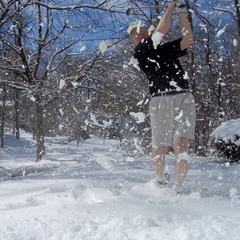-
Posts
45 -
Joined
-
Last visited
About 406pat

Personal Information
-
Your Location
Auburn, wa
Your Golf Game
- Index: 18ish
- Plays: Righty
Recent Profile Visitors
1,259 profile views
406pat's Achievements
-
Another issue that I've run into is that courses don't do a very good job of indicating distances to landing zones. Can't count how many times I've heard "Think they're out of range? I don't know. Better wait". Usually I solve this problem with a rangefinder, but I find it really handy when courses show distances to some landmarks in the fairway on the hole diagram.
-
I play single length in the long irons (4,5,6) and love them. The one thing I struggle with is subconciously swinging too hard with the low irons to get them to go. Don't need to but I still try on occasion. To try it out, I cut down a set of Callawy cavity backs and used solder and silicone to get the weights right. I also had them bent to the right lie angle. Just this year, I put together a set of Cobra F7s with the long irons one lenght and "conventional" length from the 7 on down. I love it and don't see myself going back any time soon.
-
It is a great way to play through.
-
In my 30 odd years of golf I've never been waved up. Waving up doesn't help as much as one would think anyway as far as the course as a system goes. In most cases, the time "made up" by waving up is lost waiting on the very next tee. In some cases where is a long, roundabout path from the tee to the green it can help but more often than not can hurt lead to dangerous situations. Courses can actually set themselves up for litigation by making waving up a rule.
-
... for that group. Meanwhile the group directly behind them is waiting for the green to clear while the group behind them is waiting for the landing zone to clear. Just because the light turns green doesn't mean every car can start going, you still have to wait for the car in front of you to move. Just because groups have space in front of them doesn't mean they can make it up. If they could, there would be no long rounds and all would be right with the world. If a group of 20 handicap players is going as fast as they can before they hit a backup, they can't play faster with a gap in front of them. I see this all the time at saturated courses with sub 10 minute tee time intervals. When they're actually playing, their pace is fine. They get caught in a 3 group backup on a par three and two holes later, they're a hole behind. The marshall sees a hole gap and tells them to get moving, but they haven't done anything wrong. They get pissed because they'd still be on a sub 4 hour pace without the 15 minute delay they had on the 3rd tee! Is it right to ask them to skip a hole when the course set them up to fail?
-
That's true for the individual group, but not for the system. If we call the group in front of us #1, we're in group #2, and the group behind us is #3, etc., we'll have a gap between us and #1. We can play faster and make up that gap. Our round time might not even show the delay. The problem is, that delay is still rippling backwards through the groups behind us. It generally takes 5-7 minutes for a foursome to hit their first and second shots and clear the landing zone. So if we spent only 5 extra minutes looking for and hitting the lost ball, Group #3 had to wait the standard 30 seconds on the tee + 5 minutes . Meanwhile, (since there's no buffer between groups if we're waiting each tee) group #4 finished up hole 4 and is waiting on the tee behind group #3. Group #3 is still going to take 5-7 minutes to hit their tee shots and clear the landing area. they might play faster after that if we play faster, but they aren't going to clear that first landing area appreciably faster. That means group #4 is going to feel that same 5 1/2 min delay. With no buffer, that delay will be imparted on every group after us. It can be made up over the round if everyone plays faster when they can, and if there're no more delays on the day. That doesn't happen though. More groups are going to have delays throughout the day at different spots. It's like being stuck in bumper to bumper traffic (zero buffer). Once the first car hits the brakes, every car behind them has to. that delay doesn't go away until traffic dies down a lot. That's why there's delays on freeways for hours after wrecks are cleared up in heavy traffic. If there's space between the cars, the second may have to stop, the third may slow, and the fourth might not even be impacted.
-
There's way more to it than individual playing times. When you look at the course as a system, the time to play all 18 isn't nearly as important as the time it takes to play each individual hole. Take a saturday with a full tee sheet where the course says pace is 4:15 and tee times are 9 minutes apart. The first group finished in 3:45, but they had a 5 minute delay on 16 for a couple lost balls. There are very few courses where every group can be clear to hit on every hole at a 9 minute inteval so there is no buffer between groups. Every group behind them now has a delay and a full tee sheet means that delay will never go away, even if every group that day is capable of playing a 3:45 round. If the first group started at 6 am then there's 40 groups that have started by noon. If only half of those groups have one blow up hole that delays a group behind them for 2 minutes, that's a 40 minute delay added to the round by noon that the players themselves have no control over.
-
Very true. That's also about when the COR rules were implemented... another variable that isn't controlled for. I'm not trying to nay say the data or dispute that it's an interesting correlation worth looking into. Just trying to point out that jumping to the conclusion that head size is the problem with driver distance is premature with this data set. In fact, I see this data as strongly suggesting that the answer for question 2 in the poll is that several factors contribute heavily to the distance problem for those that vote there's a problem.
-
Looks pretty convincing but correlation doesn't equal causation. There are too many variables that aren't controlled. This data set could be comparing a 150 cc persimmon head with steel shaft hitting a wound balata to a 460cc Taylormade M2 with a custom graphite shaft cranking a ProV1X. It's thought provoking but the only thing the original graph told us for sure is that clubhead size and driving distance have been increasing on the tour since 1980.
-
Rule 20-3d(i) d. Ball Fails to Come to Rest on Spot If a ball when placed fails to come to rest on the spot on which it was placed, there is no penalty and the ball must be replaced. If it still fails to come to rest on that spot: (i) except in a hazard, it must be placed at the nearest spot where it can be placed at rest that is not nearer the hole and not in a hazard; The way I see it, the ball isn't holed and is at rest. You mark, remove the impediment, and go to replace. The ball can't be at rest before it goes into the hole once the impediment is removed so it must be placed outside of the hole far enough that it can come to rest and then be tapped in. No penalty but not automatically holed either.
-
It's really too bad because a lot courses could increase playing flow and the playing experience with legitimate tee time intervals and active course management. They hold off because, on paper, you get more players through the course with 8 minute tee times than 11. In practice, compressed tee times give you angry golfers, increasing round durations, and fewer groups completing 18 hole rounds in a day because most courses can't process a group every 8 minutes. Most course would actually make more money by having the right tee time intervals because rounds would be consistently faster and more players actually complete 18 holes. Playing through wouldn't be nearly the issue it is if folks weren't playing a freeway at rush hour every Saturday.
-
The biggest problem on most public courses is saturation and lack of player assistance on the course. Sending groups off every 8 minutes when it generally takes a group 10 -11 to play an average par 3 is asking for trouble. That's often the true cause of the holdup and the frustration builds when you see the group in front playing "slow" when really they were set up to fail. A full course will inevitably have delays, purely from variability. But a course properly managed for pace will have player assistants helping the groups who are off pace, and enforcing the rules if need be. Really, playing through should be a common thing that courses manage. I think the reason it gets contentious is that there really is no place to go on a saturated course. Gaps are a necessity to maintain the pace of play for all groups on a full course. Just because there's a gap doesn't mean there should be a group filling it and filling the wrong gap can lead to more problems than it fixes.
-
No need to test. It can be proven with the equation V2^2=V1^2+2ad where V1 is initial velocity V2 is final velocity, a is acceleration, and d is distance traveled. Lets say V1=10 ft/s and that is just enough to go 10 ft so V2=0. Solve for acceleration and you get -5 ft/s^2. Next assume a faster green with the same stroke and the putt goes 2' past. Change d to 12 feet and acceleration equals -4.167 ft/s^2. Finally assume a slower green same stroke and the putt stops 2' short. Change d to 8' and acceleration equals -6.25 ft/s^2. Looking at the differences between slow/control and fast/control the acceleration of the slow green is 25% different and the fast green is 16% different. So a green must be 25% slower to have the same impact on distance as a green only 16% faster. Put another way, if the acceleration of the fast green was changed as much as the slow green, the value would be -3.7 ft/s^2 and the distance traveled would be 13.3 feet or 3.3 feet long. If acceleration is the only variable, distance becomes more sensitive to initial velocity as acceleration approaches zero.
-
I think the two problems we are struggling with are the sheer number of variables involved and the ambiguity of what "better" means. I would argue that, if all else was equal, physics would say a slower green was better. A higher rate of deceleration means that the distance traveled is less sensitive to initial speed. The faster a green is, the greater the difference between distance traveled will be for a given change per unit of initial speed. This means a slower green is more forgiving distance wise. A slower green also allows the player to hit the ball faster, giving less time for gravity to act on the ball on side slopes. Since acceleration is a function of time, the less time the ball is moving, the less it is impacted, the less it breaks. Further, a slower green would have more friction resisting the acceleration force of gravity so the net break would be less. That all says that a slower green will break less and will not require as much correction in initial alignment as a faster green will. Problem solved. Physics says so. Hardly! As others have brought up, all else is not equal. Players are of different abilities and comfort ranges and playing surfaces are not uniform through different speeds (i.e. longer usually bumpier). I think that @criley4way is probably on the right track and I would be surprised if all of the "unknowable variables" ended up creating something close to a normal distribution for any metric of "better" that we choose to use. # of 4 putts, # of 3 putts, feet of putting, strokes gained, anything. One thing I am sure of is that any statistical analysis of a population will be accurate for the population, but is hardly ever right for an individual in the population. Even if we find a statistically perfect magical stimp for all of us, I bet just about everyone would want it a little faster or a little slower.








